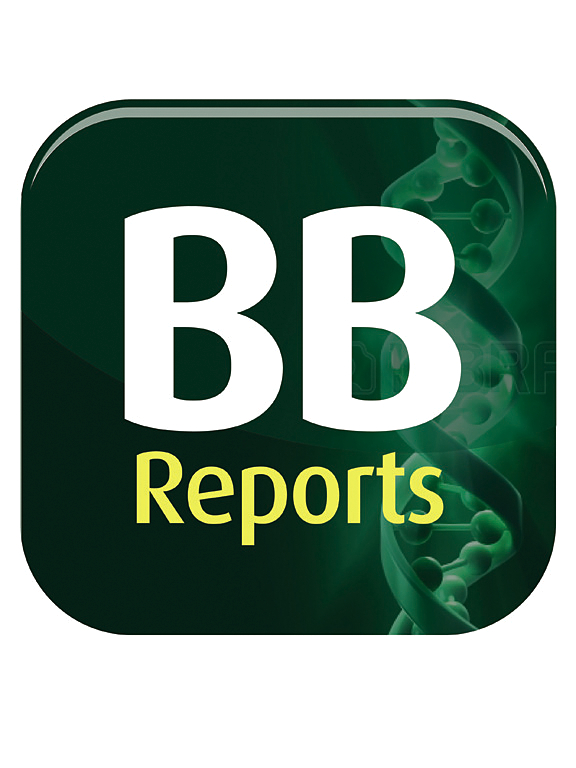新的乳腺癌标志物BF-09在肿瘤提取物中过表达,并在血清中分泌
IF 2.2
Q3 BIOCHEMISTRY & MOLECULAR BIOLOGY
引用次数: 0
摘要
背景CA 15-3和CA 27-29是广泛应用于乳腺癌的血清生物标志物,但由于在早期疾病中的敏感性较低,其效用有限。本研究详细介绍了一种具有广泛应用潜力的新型乳腺癌标志物BF-09的发现。方法采用免疫筛选阵列对肿瘤活检提取物(n = 115)和非肿瘤标本(n = 190)进行抗体筛选。Western blot测定抗体靶点的分子量,检测在细胞培养基中的分泌情况。建立了一种夹心酶联免疫吸附试验,并对小鼠异种移植物血清进行了体内分泌试验。一组初步的癌症(n = 14)和非癌症(n = 13)人类血清样本进行了类似的测试,以确认该生物标志物可以在人类血液中测量。使用HuProt Human Protein Array进行靶蛋白鉴定。结果选择bf -09抗体进行进一步研究是因为其蛋白靶点在早期和晚期肿瘤提取物中均升高(p <;0.05)。Western blot结果显示,BF-09抗体对约15 kDa的蛋白条带发生反应。ELISA结果证实该生物标志物在小鼠和人血清中均有可定量分泌。肿瘤患者血清中BF-09蛋白的中位浓度较高(p <;0.0001),与非癌症患者相比。噬菌体显示和HuProt阵列显示蛋白靶点为saga相关因子29。结论BF-09在早期肿瘤组织中表达升高,血清中分泌量可测,是一种有前景的乳腺癌标志物,值得进一步研究。本文章由计算机程序翻译,如有差异,请以英文原文为准。
New breast cancer marker BF-09 is overexpressed in tumor extracts and secreted in serum
Background
CA 15-3 and CA 27–29 are widely used serum biomarkers for breast cancer with limited utility due to low sensitivity in early-stage disease. This study details the discovery of BF-09, a new breast cancer marker with potential for wider application.
Method
Antibodies were screened against tumor biopsy extracts (n = 115) relative to non-cancer (n = 190) specimens using an immunoscreening array. Western blot was done to determine the molecular weight of the antibody target and test secretion in cell culture medium. A sandwich ELISA was developed and tested on mouse xenograft serum to confirm in vivo secretion. A preliminary set of cancer (n = 14) and non-cancer (n = 13) human serum samples was similarly tested to confirm the biomarker could be measured in human blood. HuProt Human Protein Array was used for target protein identification.
Results
BF-09 antibody was selected for further study because its protein target was elevated in both early and late-stage cancer extracts (p < 0.05). On Western blot, BF-09 antibody reacted against a protein band of around 15 kDa. ELISA results confirmed that the biomarker was secreted in both mouse and human serum in quantifiable amounts. BF-09 protein had higher median concentration in serum of cancer patients (p < 0.0001) compared to non-cancer patients. Phage display and HuProt array revealed the protein target as SAGA-associated factor 29.
Conclusion
Due to its elevated presence in early-stage tumor tissue and its measurable secretion into serum, BF-09 is a promising breast cancer marker for further study.
求助全文
通过发布文献求助,成功后即可免费获取论文全文。
去求助
来源期刊

Biochemistry and Biophysics Reports
Biochemistry, Genetics and Molecular Biology-Biophysics
CiteScore
4.60
自引率
0.00%
发文量
191
审稿时长
59 days
期刊介绍:
Open access, online only, peer-reviewed international journal in the Life Sciences, established in 2014 Biochemistry and Biophysics Reports (BB Reports) publishes original research in all aspects of Biochemistry, Biophysics and related areas like Molecular and Cell Biology. BB Reports welcomes solid though more preliminary, descriptive and small scale results if they have the potential to stimulate and/or contribute to future research, leading to new insights or hypothesis. Primary criteria for acceptance is that the work is original, scientifically and technically sound and provides valuable knowledge to life sciences research. We strongly believe all results deserve to be published and documented for the advancement of science. BB Reports specifically appreciates receiving reports on: Negative results, Replication studies, Reanalysis of previous datasets.
 求助内容:
求助内容: 应助结果提醒方式:
应助结果提醒方式:


